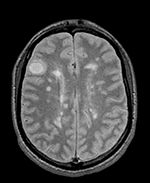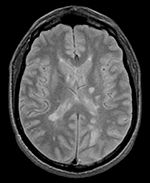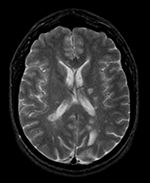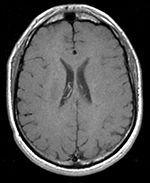Difference between revisions of "Projects:RegistrationLibrary:RegLib C04"
| Line 5: | Line 5: | ||
==Slicer Registration Library Case 04: Intra-subject Brain MR of Multiple Sclerosis: Multi-contrast series for lesion change assessment == | ==Slicer Registration Library Case 04: Intra-subject Brain MR of Multiple Sclerosis: Multi-contrast series for lesion change assessment == | ||
{| style="color:#bbbbbb; background-color:#333333;" cellpadding="10" cellspacing="0" border="0" | {| style="color:#bbbbbb; background-color:#333333;" cellpadding="10" cellspacing="0" border="0" | ||
| − | |[[Image: | + | |[[Image:Reglib_C04_Thumb_PD1.jpg|150px|lleft|this is the fixed reference image. All images are aligned into this space]] |
| − | |[[Image: | + | |[[Image:RReglib_C04_Thumb_T21.jpg|150px|lleft|this is a passive image to which the calculated transform is applied. It is a label-map in the same space as the moving FLAIR image]] |
| + | |[[Image:RReglib_C04_Thumb_Gd1.jpg|150px|lleft|this is a passive image to which the calculated transform is applied. It is a label-map in the same space as the moving FLAIR image]] | ||
|[[Image:Arrow_left_gray.jpg|100px|lleft]] | |[[Image:Arrow_left_gray.jpg|100px|lleft]] | ||
| − | |[[Image: | + | |[[Image:Reglib_C04_Thumb_PD2.jpg|150px|lleft|this is the moving image. The transform is calculated by matching this to the reference image]] |
| − | |[[Image: | + | |[[Image:Reglib_C04_Thumb_T22.jpg|150px|lleft|this is a passive image to which the calculated transform is applied. It is a label-map in the same space as the moving FLAIR image]] |
| + | |[[Image:Reglib_C04_Thumb_Gd2.jpg|150px|lleft|this is a passive image to which the calculated transform is applied. It is a label-map in the same space as the moving FLAIR image]] | ||
|align="left"|LEGEND<br><small><small> | |align="left"|LEGEND<br><small><small> | ||
[[Image:Button_red_fixed.jpg|20px|lleft]] this indicates the reference image that is fixed and does not move. All other images are aligned into this space and resolution<br> | [[Image:Button_red_fixed.jpg|20px|lleft]] this indicates the reference image that is fixed and does not move. All other images are aligned into this space and resolution<br> | ||
[[Image:Button_green_moving.jpg|20px|lleft]] this indicates the moving image that determines the registration transform. <br> | [[Image:Button_green_moving.jpg|20px|lleft]] this indicates the moving image that determines the registration transform. <br> | ||
| − | |||
[[Image:Button_blue_tag.jpg|20px|lleft]] this indicates images that passively move into the reference space, i.e. they have the transform applied but do not contribute to the calculation of the transform. | [[Image:Button_blue_tag.jpg|20px|lleft]] this indicates images that passively move into the reference space, i.e. they have the transform applied but do not contribute to the calculation of the transform. | ||
</small></small> | </small></small> | ||
|- | |- | ||
| − | |[[Image:Button_red_fixed.jpg|40px|lleft]] | + | |[[Image:Button_red_fixed.jpg|40px|lleft]] PD axial |
| − | |[[Image: | + | |[[Image:Button_red_fixed.jpg|40px|lleft]] T2 axial |
| + | |[[Image:Button_green_moving.jpg|40px|lleft]] T1-GdDTPA | ||
| | | | ||
| − | |[[Image:Button_green_moving.jpg|40px|lleft]] T2 | + | |[[Image:Button_green_moving.jpg|40px|lleft]] PD axial |
| − | |[[Image:Button_blue_tag.jpg|40px|lleft]] | + | |[[Image:Button_blue_tag.jpg|40px|lleft]] T2 axial |
| + | |[[Image:Button_blue_tag.jpg|40px|lleft]] T1-GdDTPA | ||
|- | |- | ||
| − | | | + | |0.9375 x 0.9375 x 3 mm axial<br> 256 x 256 x 51<br>RAS |
| − | | | + | |0.9375 x 0.9375 x 3 mm axial<br> 256 x 256 x 51<br>RAS |
| + | |0.9375 x 0.9375 x 5 mm axial<br> 256 x 256 x 24<br>RAS | ||
| | | | ||
| − | | | + | |0.9375 x 0.9375 x 3 mm axial<br> 256 x 256 x 54<br>RAS |
| − | | | + | |0.9375 x 0.9375 x 3 mm axial<br> 256 x 256 x 54<br>RAS |
| + | |0.9375 x 0.9375 x 5 mm axial<br> 256 x 256 x 24<br>RAS | ||
|} | |} | ||
===Objective / Background === | ===Objective / Background === | ||
| − | This scenario occurs in many forms whenever we wish to | + | This scenario occurs in many forms whenever we wish to assess change in a series of multi-contrast MRI. The follow-up scan(s) are to be aligned with the baseline, but also the different series within each exam need to be co-registered, since the subject may have moved between acquisitions. Hence we have a set of nested registrations. This particular exam features a dual echo scan (PD/T2), where the two structural scans are aligned by default. The post-contrast T1-GdDTPA scan however is not necessarily aligned with the dual echo. Also the post-contrast scan is taken with a clipped field of view (FOV) and a lower axial resolution, with 4mm slices and a 1mm gap (which we treat here as a de facto 5mm slice). |
=== Keywords === | === Keywords === | ||
| − | MRI, brain, head, intra-subject, | + | MRI, brain, head, intra-subject, multiple sclerosis, MS, multi-contrast, change assessment, dual echo, nested registration |
===Input Data=== | ===Input Data=== | ||
| − | *[[Image:Button_red_fixed_white.jpg|20px]]reference/fixed : | + | *[[Image:Button_red_fixed_white.jpg|20px]]reference/fixed : PD baseline exam , 0.9375 x 0.9375 x 3 mm voxel size, axial acquisition, RAS orientation. |
| − | *[[Image: | + | *[[Image:Button_red_fixed_white.jpg|20px]]reference/fixed : T2 baseline exam , 0.9375 x 0.9375 x 3 mm voxel size, axial acquisition, RAS orientation. |
| − | *[[Image: | + | *[[Image:Button_green_moving_white.jpg|20px]] moving: T1-GdDTPA baseline exam 0.9375 x 0.9375 x 5 mm voxel size, axial acquisition. |
| − | *[[Image: | + | *[[Image:Button_green_moving_white.jpg|20px]] moving: PD follow-up exam 0.9375 x 0.9375 x 3 mm voxel size, axial acquisition. |
| − | * | + | *[[Image:Button_blue_tag_white.jpg|20px]]tag: T2 follow-up exam 0.9375 x 0.9375 x 3 mm voxel size, axial acquisition. |
| + | *[[Image:Button_green_moving_white.jpg|20px]] moving:T1-GdDTPA follow-up exam0.9375 x 0.9375 x 5 mm voxel size, axial acquisition. | ||
===Registration Challenges=== | ===Registration Challenges=== | ||
| − | * | + | *we have multiple nested transforms: each exam is co-registered within itself, and then the exams are aligned to eachother |
| − | + | *potential pathology change can affect the registration | |
| − | + | *anisotropic voxel size causes difficulty in rotational alignment | |
| − | * | + | *clipped FOV and low tissue contrast of the post-contrast scan |
| − | * | ||
| − | |||
| − | * | ||
| − | |||
===Key Strategies=== | ===Key Strategies=== | ||
| − | *we | + | *we first register the post-contrast scans within each exam to the PD |
| − | *the | + | *we also move the T2 exam within the same Xform |
| − | *because of the contrast differences and | + | *second we register the follow-up PD scan to the baseline PD |
| − | * | + | *we then nest the first alignment within the second |
| + | *we compare T1Gd to T1Gd, which went through 2 transforms. We correct residual misalignment with a 3rd correction transform | ||
| + | *because of the contrast differences and anisotropic resolution we use Mutual Information as cost function for better robustness | ||
| + | *we adjust the expected translation and rotational parameter settings to the visual assessment of the input data (i.e. initial misalignment) | ||
=== Registration Results=== | === Registration Results=== | ||
Revision as of 21:53, 19 February 2010
Home < Projects:RegistrationLibrary:RegLib C04Back to ARRA main page
Back to Registration main page
Back to Registration Use-case Inventory
Contents
Slicer Registration Library Case 04: Intra-subject Brain MR of Multiple Sclerosis: Multi-contrast series for lesion change assessment

|
this is a passive image to which the calculated transform is applied. It is a label-map in the same space as the moving FLAIR image | this is a passive image to which the calculated transform is applied. It is a label-map in the same space as the moving FLAIR image | 
|

|

|
LEGEND
| |
| 0.9375 x 0.9375 x 3 mm axial 256 x 256 x 51 RAS |
0.9375 x 0.9375 x 3 mm axial 256 x 256 x 51 RAS |
0.9375 x 0.9375 x 5 mm axial 256 x 256 x 24 RAS |
0.9375 x 0.9375 x 3 mm axial 256 x 256 x 54 RAS |
0.9375 x 0.9375 x 3 mm axial 256 x 256 x 54 RAS |
0.9375 x 0.9375 x 5 mm axial 256 x 256 x 24 RAS |
Objective / Background
This scenario occurs in many forms whenever we wish to assess change in a series of multi-contrast MRI. The follow-up scan(s) are to be aligned with the baseline, but also the different series within each exam need to be co-registered, since the subject may have moved between acquisitions. Hence we have a set of nested registrations. This particular exam features a dual echo scan (PD/T2), where the two structural scans are aligned by default. The post-contrast T1-GdDTPA scan however is not necessarily aligned with the dual echo. Also the post-contrast scan is taken with a clipped field of view (FOV) and a lower axial resolution, with 4mm slices and a 1mm gap (which we treat here as a de facto 5mm slice).
Keywords
MRI, brain, head, intra-subject, multiple sclerosis, MS, multi-contrast, change assessment, dual echo, nested registration
Input Data
 reference/fixed : PD baseline exam , 0.9375 x 0.9375 x 3 mm voxel size, axial acquisition, RAS orientation.
reference/fixed : PD baseline exam , 0.9375 x 0.9375 x 3 mm voxel size, axial acquisition, RAS orientation. reference/fixed : T2 baseline exam , 0.9375 x 0.9375 x 3 mm voxel size, axial acquisition, RAS orientation.
reference/fixed : T2 baseline exam , 0.9375 x 0.9375 x 3 mm voxel size, axial acquisition, RAS orientation. moving: T1-GdDTPA baseline exam 0.9375 x 0.9375 x 5 mm voxel size, axial acquisition.
moving: T1-GdDTPA baseline exam 0.9375 x 0.9375 x 5 mm voxel size, axial acquisition. moving: PD follow-up exam 0.9375 x 0.9375 x 3 mm voxel size, axial acquisition.
moving: PD follow-up exam 0.9375 x 0.9375 x 3 mm voxel size, axial acquisition. tag: T2 follow-up exam 0.9375 x 0.9375 x 3 mm voxel size, axial acquisition.
tag: T2 follow-up exam 0.9375 x 0.9375 x 3 mm voxel size, axial acquisition. moving:T1-GdDTPA follow-up exam0.9375 x 0.9375 x 5 mm voxel size, axial acquisition.
moving:T1-GdDTPA follow-up exam0.9375 x 0.9375 x 5 mm voxel size, axial acquisition.
Registration Challenges
- we have multiple nested transforms: each exam is co-registered within itself, and then the exams are aligned to eachother
- potential pathology change can affect the registration
- anisotropic voxel size causes difficulty in rotational alignment
- clipped FOV and low tissue contrast of the post-contrast scan
Key Strategies
- we first register the post-contrast scans within each exam to the PD
- we also move the T2 exam within the same Xform
- second we register the follow-up PD scan to the baseline PD
- we then nest the first alignment within the second
- we compare T1Gd to T1Gd, which went through 2 transforms. We correct residual misalignment with a 3rd correction transform
- because of the contrast differences and anisotropic resolution we use Mutual Information as cost function for better robustness
- we adjust the expected translation and rotational parameter settings to the visual assessment of the input data (i.e. initial misalignment)
Registration Results
 Registration Result: FLAIR + segmentation aligned with SPGR
Registration Result: FLAIR + segmentation aligned with SPGR
Download
- Registration Library Case 04: MS Multi-contrast series (PD,T2, T1-GdDTPA): Lesion change assessment (Data,Presets, Solution, zip file 17 MB)
- download/view guided video tutorial
- download power point tutorial
Link to User Guide: How to Load/Save Registration Parameter Presets